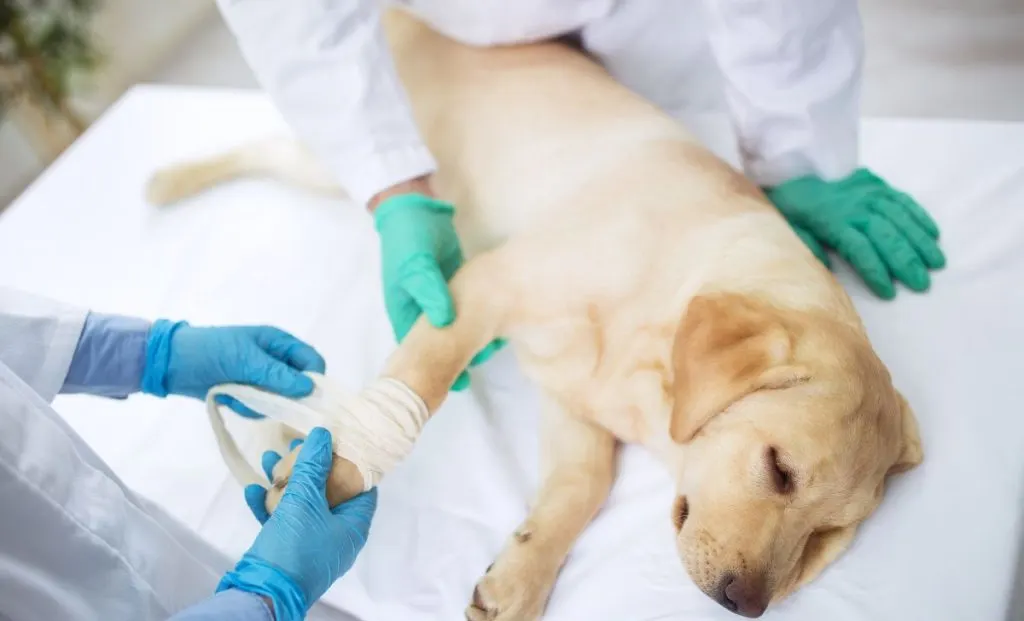Did you know that hip and elbow dysplasia affects many large breed dogs, including popular breeds like Labrador Retrievers and German Shepherd dogs?
These genetic ailments can seriously affect a dog’s quality of life, as they lead to deformed elbows, restricted range of motion in the hip joints, and debilitating osteoarthritis.
In this article, we’ll explore the distinct features of hip and elbow dysplasia in dogs, including how they impact the growth plates and joints, what the best treatment options are, and how moderate exercise and physical therapy can make a big difference.
We’ll also delve into the costs associated with surgical treatments and discuss whether affected dogs can live fulfilling lives without surgery.
So, if your dog has a good leg and a bad one and you’re curious about how these conditions are managed, we are here to offer some valuable information and tips!
Understanding Hip And Elbow Dysplasia In Dogs

Hip and elbow dysplasia are orthopedic issues in canines, which affect their mobility and quality of life.
The term dysplasia refers to ‘’abnormal growth’’. It means that something (tissues, organs, or cells) grows or develops in an unusual way.
In medical and veterinary contexts, it often refers to joints, like hips or elbows, that don’t form correctly, leading to problems like instability, pain, and reduced function.
These developmental disorders affect different breeds at varying rates.
Therefore, understanding the frequency and characteristics of these health problems is very important for managing and increasing the quality of life for affected dogs.
What Is Hip Dysplasia?
Canine hip dysplasia (CHD) is a genetic disorder characterized by abnormal development of the hip joint, which can lead to joint instability, subluxation, or even dislocation.
The dog’s hip joint is a synovial joint. This is a ball-and-socket type of joint, where the ball (femoral head) should fit snugly into the socket (acetabulum) of the pelvis.
Dogs with hip dysplasia have an improperly developed hip, which eventually results in instability, discomfort, and lameness.
Among a broad population of dogs, the overall incidence of hip dysplasia (HD) is around 0.83%, and elbow dysplasia (ED) is about 2.08% (1).
However, some breeds have higher rates. For instance, in South Africa, hip dysplasia affects 22% of Rottweilers and 31% of Labrador Retrievers.
What Is Elbow Dysplasia?
Elbow dysplasia (ED) is another genetic disorder affecting the elbow joints of dogs, leading to several specific conditions such as fragmented coronoid process (FCP), osteochondritis dissecans (OCD), and ununited anconeal process (UAP).
These conditions result in the improper development of the elbow joints.
For example, abnormalities in the medial coronoid process can lead to a deformed elbow, significantly impacting the dog’s range of motion and causing considerable pain.
Elbow dysplasia is typically diagnosed in young dogs, often around the months of age when they are still growing.
Large breed dogs are more commonly affected by this condition.
In fact, Elbow dysplasia is found in 39% of Rottweilers and 19% of Labrador Retrievers (2).
What Causes Hip And Elbow Dysplasia In Dogs?

Primarily, these are genetic disorders, meaning they can be inherited from the dog’s parents.
This is why large dogs like Labrador Retrievers, German Shepherd Dogs, Rottweilers, Golden Retrievers, and Bernese Mountain Dogs are more prone to developing these conditions.
Young dogs from such breeds can develop dysplasia due to rapid growth rate. When puppies grow too quickly, their growth plates can’t keep up, leading to improper development of the hip and elbow joints.
This rapid growth rate, combined with excessive weight gain, adds stress to these developing joints, worsening the situation.
The extra weight, either in front or hind legs, increases pressure and creates even more pain and discomfort.
Besides genetics, environmental factors such as certain types of physical activity also play a role.
High-impact exercises or activities that strain the joints can contribute to the development or worsening of dysplasia.
Can a dog have both hip and elbow dysplasia?
Yes, a dog can have both hip and elbow dysplasia although it is relatively uncommon.
Both conditions are often studied together due to their genetic and developmental nature.
Research has shown that these conditions can be managed and reduced through selective breeding practices.
For instance, the Orthopedic Foundation for Animals (OFA) has a registry for hip and elbow conformation, which helps in tracking and improving the genetic quality of dog breeds over time.
So, while having both hip and elbow dysplasia is less common, it is certainly possible due to shared risk factors like genetics, rapid growth, and excessive weight gain.
But how can you recognize the symptoms early to make sure your canine remains as healthy as a horse?
Recognizing Hip And Elbow Dysplasia in Dogs

With hip and elbow dysplasia in dogs being such common health problems, it’s really important to notice the symptoms as early as possible.
Catching hip and elbow dysplasia early can make a big difference. When these conditions are identified early, you can start treatments that help reduce pain and improve your dog’s ability to move.
If you wait too long, the problems can get worse, making it harder for your dog to walk and play.
So, here’s a quick overview of the symptoms:
| Symptom | Hip Dysplasia | Elbow Dysplasia |
| Limping or Lameness | Back legs | Front legs |
| Difficulty Rising | Yes | No |
| Decreased Activity | Yes | Yes |
| Bunny Hopping Gait | Yes | No |
| Stiffness | After rest | No |
| Pain | Hip area | Elbow area |
| Swelling | No | Elbow joints |
| Abnormal Walking | No | Irregular gait |
Your dog might also show stiffness, especially after resting, and pain when you touch their hips.
Elbow dysplasia affects the front legs, making it hard for dogs to move their elbows properly.
Symptoms include limping or lameness in the front legs, difficulty extending the elbows fully, and visible swelling around the elbow joints.
Pain when touching the elbows, decreased activity, and an abnormal walking pattern, often favoring one leg over the other, are also common signs.
Now, symptoms of lameness may not occur until affected dogs are 6 to 8 years of age. This is usually the time when signs of age-related health problems (like arthritis) start to show up.
Do Dogs Limp All The Time With Elbow Dysplasia?
No, dogs do not limp all the time with elbow dysplasia.
The limping may come and go, often becoming more noticeable after exercise or periods of activity.
It all depends on the condition and the level of joint stress the dog experiences.
Some dogs may show consistent limping, while others might only limp occasionally, especially after rigorous play or exercise.
How Painful Is Elbow Dysplasia In Dogs?
Elbow dysplasia can be quite painful for dogs.
The level of pain (mild to severe) really depends on how much the joint is damaged. It also depends on the presence of other conditions, such as osteoarthritis.
Dogs with elbow dysplasia often show signs of pain such as reluctance to play, difficulty moving, and sensitivity when the elbow area is touched.
Diagnosing Hip And Elbow Dysplasia in Dogs

For a young dog showing clinical signs of dysplasia, early diagnosis through hip radiographs and elbow grades can make a positive influence on their quality of life.
Hip Dysplasia Diagnosis
When a young dog comes in with symptoms such as limping, stiffness, or difficulty rising, vets start by taking a detailed history (anamnesis) and conducting a thorough physical examination.
Hip radiographs are essential for diagnosing hip dysplasia. These X-ray images allow us to assess the structure of the hip joints.
We look for signs of abnormal development, such as a shallow acetabulum or a misshapen femoral head.
The radiographic images are then scored, providing a final score that indicates the severity of the dysplasia.
This hip score system ranges from a minimum score, indicating mild dysplasia, to the maximum possible score, indicating severe dysplasia.
Each dog’s condition is unique, and every case is treated on an individual basis.
Elbow Dysplasia Diagnosis
Diagnosing elbow dysplasia involves a similar process.
When elbow dysplasia is suspected, veterinarians usually take radiographs of the elbow joints.
These images are assessed based on specific elbow grade parameters, such as the presence of bone fragments, the degree of joint deformity, and signs of osteoarthritis.
The results are given an elbow grade ranging from 0 (normal) to 3 (severe dysplasia).
This elbow grade data is invaluable in planning the treatment.
So, by examining the elbow grade parameters, we can tailor the treatment to the severity of the condition.
For example, a dog with a lower grade might benefit from weight management and physical therapy, while a higher grade might require more intensive interventions.
How Do You Treat Hip And Elbow Dysplasia In Dogs?

Treating hip and elbow dysplasia in dogs, especially large breeds involves a mix of lifestyle changes, medical care, and sometimes surgery.
Non-surgical management is usually the first step, especially for mild to moderate cases. This includes weight loss, physical rehab, and medications.
Weight Loss
Your dog being overweight puts more mechanical strain on their joints, which worsens dysplasia-related pain and inflammation.
So, keeping your dog at a healthy weight is crucial because extra weight can worsen joint stress and symptoms. A balanced diet and controlled feeding help manage weight effectively (3).
Premium dog food designed for joint health can do wonders for dogs with hip and elbow dysplasia. This type of food helps improve their overall health and mobility.
Combining joint-health food with routine vet visits ensures your dog gets the best care possible for their condition.
Physical Rehabilitation
For hip dysplasia, moderate exercise, such as swimming or walking, helps maintain muscle strength without overloading the joints.
Physical rehabilitation, such as hydrotherapy and physiotherapy, aims to decrease pain, improve hip and elbow range of motion (ROM), and build or maintain muscle mass.
Studies have shown that a single hydrotherapy session can significantly increase ROM and stride length in dogs with elbow dysplasia (4).
We can clearly see that these therapies play a positive role in reducing inflammation and thus improve joint function.
Medication
Medical management typically includes pain relief with nonsteroidal anti-inflammatory drugs (NSAIDs). This medicine will help reduce pain and inflammation.
Supplements like glucosamine and chondroitin sulfate, which protect the joints, may also provide additional benefits.
Additionally, growing puppies fed a diet high in fish and supplemented with nutraceuticals showed improvements in preventing the development of severe osteoarthritis (4).
Surgical Treatments
When non-surgical treatments are insufficient, surgical intervention may be necessary.
Surgical methods may be able to relieve discomfort and restore function, depending on how severe the problem is.
Surgical treatments include:
- Arthroscopy (a minimally invasive surgery to remove bone fragments or repair joint damage),
- Osteotomy (realigning the bones to relieve pressure)
- Total elbow/hip replacement (in extreme cases)
Living With Hip And Elbow Dysplasia

As a veterinarian, I’ve seen firsthand how managing hip and elbow dysplasia can be a tough journey for both dogs and their owners.
Yet, with the right care and management, these dogs can still have pretty normal lives!
What I mean by this is that, by combining the right diet, exercise, medical management, and regular veterinary check-ups.
Is It Ok To Walk A Dog With Elbow Dysplasia?
Yes, it’s okay to walk a dog with elbow dysplasia, but you need to be careful about how you do it. You see, walking helps your dog stay strong and keeps their joints flexible.
However, it’s important not to push them too hard.
Short, frequent walks on soft surfaces like grass are better than long walks or walks on hard surfaces, which can hurt their joints.
Always watch your dog for signs that they might be uncomfortable, like limping or not wanting to move, and adjust how much they exercise based on how they’re feeling.
Talking to your vet can give you special advice tailored just for your dog.
What Is The Best Exercise For Dogs With Elbow Dysplasia?
The best exercises for dogs with elbow dysplasia are low-impact activities that build muscle without putting too much stress on the joints.
As I mentioned earlier, swimming is one of the most beneficial exercises because it allows dogs to move freely and build muscle without bearing weight on their joints.
Hydrotherapy, a form of physical therapy conducted in water, can significantly improve joint range of motion and reduce pain.
Controlled leash walks and gentle play sessions are also good options.
With that said, it’s important to avoid high-impact activities like running, jumping, or rough play, which can worsen joint issues.
Can A Dog Live With Elbow Dysplasia Without Surgery?
Yes, many dogs with elbow dysplasia can live comfortably without needing surgery, especially if the condition isn’t too severe.
With treatment options that I mentioned earlier in this article, such as weight management, physical rehabilitation like hydrotherapy, and medications or supplements, the affected dogs can still enjoy a nice life.
Costs And Prognosis

I often see that many pet owners are worried about the cost and prognosis when their dogs are diagnosed with hip or elbow dysplasia.
It’s completely understandable, as the expenses for treatments, whether surgical or non-surgical, can add up quickly, and the long-term outlook can be uncertain.
But, I may have some valuable information and tips on this topic.
How Much Does It Cost To Fix A Dog’s Elbow Dysplasia?
The cost of treating hip and elbow dysplasia in dogs varies greatly according to the severity of the condition and the type of treatment required.
In the United States, non-surgical treatments such as medication, physical therapy, and weight management can cost between $500 to $2,000 annually.
If surgical intervention is necessary, the costs can increase significantly.
Arthroscopic canine surgery, which is a minimally invasive procedure to remove bone fragments or repair joint damage, typically ranges from $2,000 to $4,000 per elbow.
More extensive surgeries like osteotomy or total elbow replacement can cost between $4,000 to $6,000 per elbow. These rates are similar for hip dysplasia.
In Europe, the costs are generally somewhat lower but can still be substantial.
Non-surgical treatments may cost between €400 and €1,800 annually.
Arthroscopic surgery in Europe typically ranges from €1,800 to €3,500 per elbow, while more complex surgeries like osteotomy or total elbow replacement can cost between €3,500 and €5,500 per elbow.
Considering these costs, I would highly advise pet owners to invest in pet health insurance.
These insurances can help cover the big expenses associated with the diagnosis and treatment of hip and elbow dysplasia.
How Long Will My Dog Live With Elbow Dysplasia?
Since the condition itself isn’t life-threatening, many dogs with elbow dysplasia can live comfortably for 10 to 15 years.
However, their total life expectancy and quality of life are determined by the severity of this condition and the efficacy of therapy.
So, make sure to understand the cause, signs, treatments, and prognosis for hip and elbow dysplasia in dogs.
This way, regardless of the obstacles, you can help your pet live a happy and active life!
Remember, when it comes to managing this health problem, your vet is your best friend, so don’t leave them in the “rear” – keep in contact and consult with them every step of the way.
References
- Hou, Y., Wang, Y., Lu, X., Zhang, X., Zhao, Q., Todhunter, R., & Zhang, Z. (2013). Monitoring Hip and Elbow Dysplasia Achieved Modest Genetic Improvement of 74 Dog Breeds over 40 Years in USA. PLoS ONE, 8. https://doi.org/10.1371/journal.pone.0076390.
- Kirberger, R. (2017). Phenotypic hip and elbow dysplasia trends in Rottweilers and Labrador retrievers in South Africa (2007–2015): Are we making progress?. Journal of the South African Veterinary Association, 88. https://doi.org/10.4102/jsava.v88i0.1534.
- Sallander, M., Hedhammar, Å., & Trogen, M. (2006). Diet, exercise, and weight as risk factors in hip dysplasia and elbow arthrosis in Labrador Retrievers.. The Journal of nutrition, 136 7 Suppl, 2050S-2052S . https://doi.org/10.1093/jn/136.7.2050S.
- Preston, T., & Wills, A. (2018). A single hydrotherapy session increases range of motion and stride length in Labrador retrievers diagnosed with elbow dysplasia.. Veterinary journal, 234, 105-110 . https://doi.org/10.1016/j.tvjl.2018.02.013.
- Manfredi, S., Ianni, F., Girolamo, N., Canello, S., Gnudi, G., Guidetti, G., Miduri, F., Fabbi, M., Daga, E., Parmigiani, E., Centenaro, S., & Volta, A. (2018). Effect of a commercially available fish-based dog food enriched with nutraceuticals on hip and elbow dysplasia in growing Labrador retrievers.. Canadian journal of veterinary research = Revue canadienne de recherche veterinaire, 82 2, 154-158 .

Meet Iram, a devoted veterinarian, passionate dog lover, and current Ph.D. candidate at Utrecht University in the Netherlands. Seamlessly blending her roles as a vet and content writer, Iram channels her love for dogs into heartfelt narratives.
Since childhood, Iram nurtured a dream of becoming a vet, a passion that runs deep in her family. Having now fulfilled that dream, she’s eager to share her acquired knowledge. In her writing, Iram not only explores the emotional bond between humans and their canine friends but also integrates her veterinary expertise, offering readers a holistic understanding of their beloved pets.
